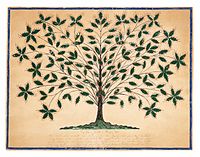
The United Society of Believers in Christ's Second Appearing, more commonly known as the Shakers, are a millenarian restorationist Christian sect founded c. 1747 in England and then organized in the United States in the 1780s. They were initially known as "Shaking Quakers" because of their ecstatic behavior during worship services. Espousing egalitarian ideals, women took on spiritual leadership roles alongside men, including founding leaders such as Jane Wardley, Ann Lee, and Lucy Wright. The Shakers emigrated from England and settled in Revolutionary colonial America, with an initial settlement at Watervliet, New York, in 1774. They practice a celibate and communal utopian lifestyle, pacifism, uniform charismatic worship, and their model of equality of the sexes, which they institutionalized in their society in the 1780s. They are also known for their simple living, architecture, technological innovation, music, and furniture.

Enfield is a town in Hartford County, Connecticut, United States, first settled by John and Robert Pease of Salem, Massachusetts Bay Colony. The population was 42,141 at the 2020 census. It is bordered by Longmeadow, Massachusetts, and East Longmeadow, Massachusetts, to the north, Somers to the east, East Windsor and Ellington to the south, and the Connecticut River to the west.

Harvard is a town in Worcester County, Massachusetts, United States. The town is located 25 miles west-northwest of Boston, in eastern Massachusetts. A farming community settled in 1658 and incorporated in 1732, it has been home to several non-traditional communities, such as Harvard Shaker Village and the utopian transcendentalist center Fruitlands. It is also home to St. Benedict Abbey, a traditional Catholic monastery. Today it is a residential town noted for its excellent public schools, with its students consistently ranking in the state's top ten test results in English and math. The population was 6,851 at the 2020 census. The official seal of the town depicts the old town public library on The Common prior to renovations that removed the front steps.

Shaker Heights is a city in Cuyahoga County, Ohio, United States. As of the 2020 Census, the city population was 29,439. Shaker Heights is an inner-ring streetcar suburb of Cleveland, abutting the eastern edge of the city's limits. In July 1911, a petition by property owners was successful in detaching a long strip of land from the south of Cleveland Heights, to be named Shaker Village. In November 1911, the voters of Shaker Village formed Shaker Heights Village, which was incorporated in January 1912. It is the birthplace of the actor Paul Newman.

Pleasant Hill, Kentucky, USA, is the site of a Shaker religious community that was active from 1805 to 1910. Following a preservationist effort that began in 1961, the site, now a National Historic Landmark, has become a popular tourist destination. Shaker Village of Pleasant Hill, or Shakertown, as it is known by residents of the area, is located 25 miles (40 km) southwest of Lexington, in Kentucky's Bluegrass region. It is a National Historic Landmark District.
Alton is a hamlet within the Town of Sodus, Wayne County, New York, United States. It is located six miles (10 km) southeast of the Village of Sodus and five miles (8 km) south of the Village of Sodus Point, at an elevation of 377 feet. The primary intersection in the hamlet is at N.Y. Route 14 and Ridge Road. N.Y. Route 104 passes just south of Alton.
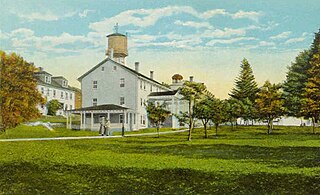
Canterbury Shaker Village is a historic site and museum in Canterbury, New Hampshire, United States. It was one of a number of Shaker communities founded in the 19th century.
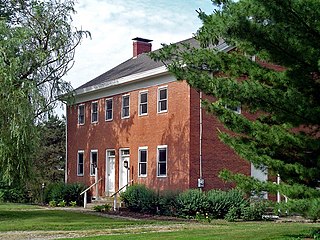
The Whitewater Shaker Settlement is a former Shaker settlement near New Haven in Crosby Township, Hamilton County, Ohio, United States. Established in 1824 and closed in 1916, it was listed on the National Register of Historic Places in 1974 as a historic district.

Sabbathday Lake Shaker Village is a Shaker village near New Gloucester and Poland, Maine, in the United States. It is the last active Shaker community, with two members as of 2020. With a new member, it had expanded to three members by 2021. The community was established in either 1782, 1783, or 1793, at the height of the Shaker movement in the United States. The Sabbathday Lake meetinghouse was built in 1794. The entire property was declared a National Historic Landmark in 1974.

Shirley Shaker Village is a historic former Shaker community in Lancaster and Shirley, Massachusetts. Defined as an historic district, it includes about half of the original buildings and is listed on the National Register of Historic Places.

The Enfield Shaker Museum is an outdoor history museum and historic district in Enfield, New Hampshire in the United States. It is dedicated to preserving and sharing the history of the Shakers, a Protestant religious denomination, who lived on the site from 1793 to 1923. The museum features exhibitions, artifacts, eight Shaker buildings and restored Shaker gardens. It is located in a valley between Mount Assurance and Mascoma Lake in Enfield.
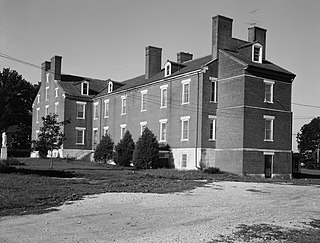
The Shaker Museum at South Union is a museum of Shaker history located at the site of the South Union Shaker Village in Auburn, Kentucky, United States.

North Union Shaker Site is a historic site in Shaker Heights, Ohio. The site was founded by Shakers in 1822 and was added to the National Register in 1974. The Shakers ran grist and grain mills from the lakes created when they dammed Doan Creek. The community ceased to exist in 1899. All of the buildings that had been part of the North Union Shaker community have been demolished, and 280 of the original 1,000 acres are Shaker Lakes parkland, which includes walking trails and a Shaker archaeological site, the Shaker Historical Museum and Library.
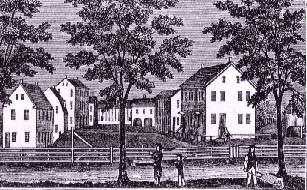
The Enfield Shakers Historic District encompasses some of the surviving remnants of a former Shaker community in Enfield, Connecticut. Founded in the 1780s, the Enfield Shaker community remained active until 1917. The surviving buildings of their once large community complexes are located in and around Taylor Road in northeastern Enfield, and were listed as a historic district on the National Register of Historic Places in 1979. The listing included 15 contributing buildings and one contributing site.

Alfred Shaker Historic District is a historic district in Alfred, Maine, with properties on both sides of Shaker Hill Road. The area had its first Shaker "believers" in 1783 following visiting with Mother Ann Lee and became an official community starting in 1793 when a meetinghouse was built. It was home to Maine's oldest and largest Shaker community. Two notable events were the songwriting of Joseph Brackett, including, according to most accounts, Simple Gifts, and the spiritual healing of the sick by the Shakers. When the Alfred Shakers products and goods were no longer competitive with mass-produced products and the membership had dwindled significantly, the village was closed in 1931 and members moved to Sabbathday Lake Shaker Village, also in Maine.
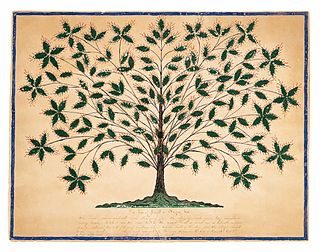
The early chronology of Shakers is a list of important events pertaining to the early history Shakers, a denomination of Christianity. Millenarians who believe that their founder, Ann Lee, experienced the Second Coming of Jesus Christ, the Shakers practice celibacy, confession of sin, communalism, ecstatic worship, pacifism, and egalitarianism. This list cover the periods from 1747 to 1826. This spans the emergence of denomination in the mid-18th century, the emigration of the Shakers to New York on the eve of the American Revolution, and subsequent missionary work and the establishment of nineteen major planned communities.

The Shakers are a sect of Christianity which practices celibacy, communal living, confession of sin, egalitarianism, and pacifism. After starting in England, the Shakers left that country for the English colonies in North America in 1774. As they gained converts, the Shakers established numerous communities in the late-18th century through the entire 19th century. The first villages organized in Upstate New York and the New England states, and, through Shaker missionary efforts, Shaker communities appeared in the Midwestern states. Communities of Shakers were governed by area bishoprics and within the communities individuals were grouped into "family" units and worked together to manage daily activities. By 1836 eighteen major, long-term societies were founded, comprising some sixty families, along with a failed commune in Indiana. Many smaller, short-lived communities were established over the course of the 19th century, including two failed ventures into the Southeastern United States and an urban community in Philadelphia, Pennsylvania. The Shakers peaked in population by the 1840s and early 1850s, with a membership between 4,000 and 9,000. Growth in membership began to stagnate by the mid 1850s. In the turmoil of the American Civil War and subsequent Industrial Revolution, Shakerism went into severe decline. As the number of living Shakers diminished, Shaker communes were disbanded or otherwise ceased to exist. Some of their buildings and sites have become museums, and many are historic districts under the National Register of Historic Places. The only active community is Sabbathday Lake Shaker Village in Maine, which is composed of at least three active members.
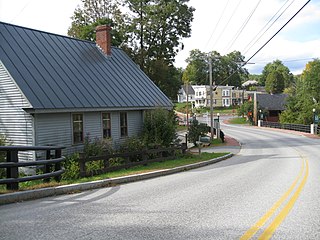
The Enfield Village Historic District encompasses the historic 19th century village center of Enfield, New Hampshire. The district was listed on the National Register of Historic Places in 2010. Multiple buildings of the district were added to the New Hampshire State Register of Historic Places in 2012.

The Louis St. Gaudens House and Studio is a historic house at Dingleton Hill and Whitten Roads in Cornish, New Hampshire. The 2+1⁄2-story gambrel-roofed wood-frame structure was designed by Moses Johnson and built in 1793–94 at the Shaker village in Enfield, New Hampshire. At that site the building served as the main meeting space for the Shakers, with a main meeting space on the ground floor, offices on the second floor, and guest living quarters in the attic space. The building is similar in construction to buildings designed by Johnson for the Shaker villages in Canterbury, New Hampshire and Sabbathday Lake, Maine.
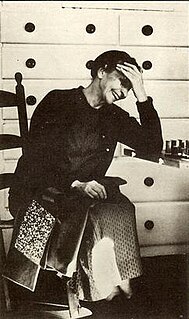
Ruth Mildred Barker was a musician, scholar, manager, and spiritual leader from the Alfred and Sabbathday Lake Shaker villages. A prominent and respected Shaker during her long life, she worked to preserve Shaker music. With the help of Daniel Patterson, she recorded Early Shaker Spirituals, a collection of Shaker songs. In recognition of her achievements in the field, in 1983 she received the National Heritage Fellowship. She also co-founded and managed The Shaker Quarterly, a magazine and journal focused on the Shakers, to which she was also a regular contributor.

